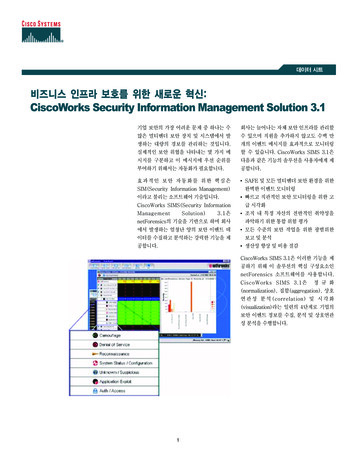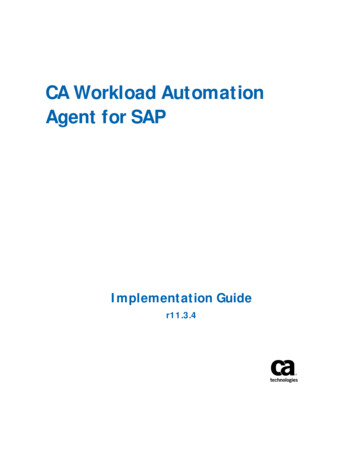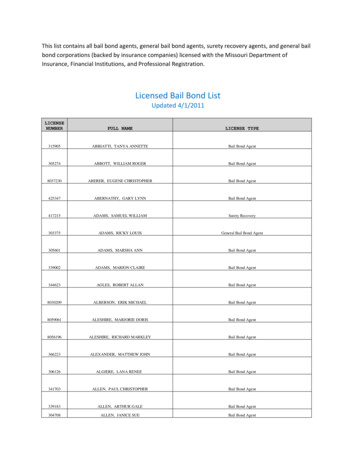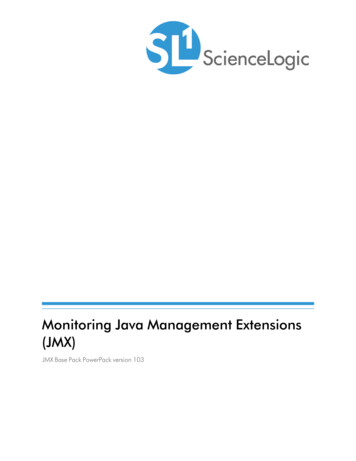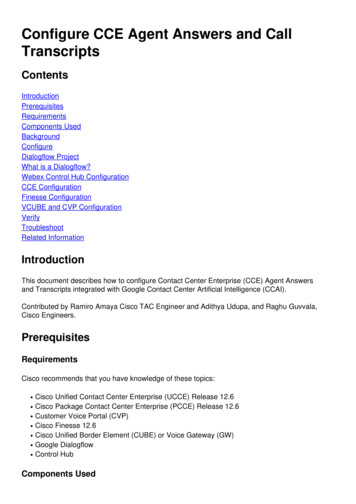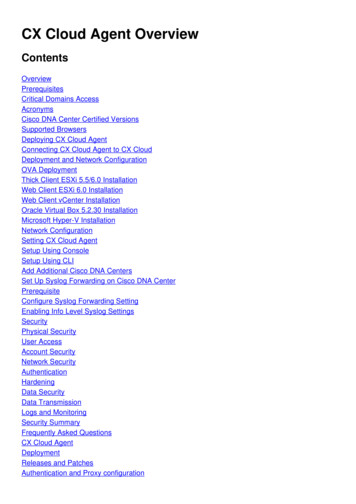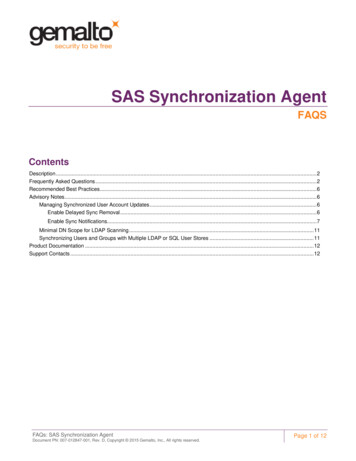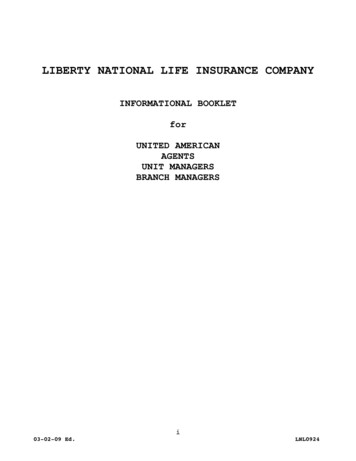
Transcription
Agent as ClientWhat you need to knowIn association with
About this guideIntroductionAgent as Client – Does your clientagreement meet the requirementsof being the Agent?About this guideInfrequently asked questionsThere are different ways in which an adviserfirm (Adviser) and a discretionaryinvestment manager (DIM/DFM) canwork together to provide a discretionaryinvestment service to the end investorbut confusion with the terminology, thedifferent nuances and the answer to‘who is the client?’ have significantimplications for Advisers.The act of an Adviser using the services ofa third-party investment manager is oftenreferred to as ‘outsourcing’ but in the FCArule book only Advisers who havediscretionary permissions can trulyoutsource to a DIM. So, if you are notoutsourcing, what are you actually doing?Diminimis has worked with the PersonalFinance Society to help clarify who isresponsible for what in the differentoperating frameworks. It is clear Advisersare unaware of the issues whilst manyDIMs continue to promote their serviceswith no clear understanding of the legaland regulatory requirements that needto be met.Research and due diligence is flawedif these issues are not considered.If you have signed an intermediaryagreement with a DIM, based on theagent as client rule, but have not read andunderstood the terms and checked yourclient agreements meet with therequirements, you may have inadvertentlyleft yourself vulnerable to future claims.This covers a lot of the MPS on platformsas well as some ‘bespoke’ solutions.Infrequently asked questions a reference guide.Further informationand case studyThis is an interactivedocument withhyperlinks throughoutWhy might some Advisers haveunintentionally over-steppedthe mark?You may have signed a legal document,the intermediary agreement, giving anundertaking to the DIM you have a levelof authority from the end investor to; Act as agent, in a legal capacity, with thepower to commit and bind the client tospecific actions. This will include theauthority to appoint a DIM.If a standard advisory agreement is in placebetween you and your client, you areunlikely to have such a level of authorityand have therefore exceeded your client’sauthority. As such this may lead to DIMs notbeing properly appointed by you as you donot have the legal power to do so.We are very grateful for Diminimis workingwith the PFS to help clarify these issues.Diminimis created this reference documentwith the help of the following specialistregulatory lawyers: Philippa Hann Dip PFS, Partner, specialistfinancial services litigator at ClarkeWillmott LLP Solicitors Alan Hughes, Partner, and TerenceDickens, Managing Associate,Foot Anstey Michael Lewis, Partner, OsborneClarke LLP.2
About this guideIntroductionAgent as Client – Does your clientagreement meet the requirementsof being the Agent?Infrequently asked questions a reference guide.Further informationand case studyBe careful what you ask for!Why do discretionaryinvestment managers(DIMs/DFMs) offer theirservices by way of the ‘agentas client’ rule? The answeris often because ‘advisersare asking for it’.However, our work with adviser firms(Adviser) and DIMs suggest there is oftena mismatch between what the Adviserunderstands by their request and what theactual situation is, often leaving the Adviserin an untenable situation.The following document covers a range ofquestions Advisers should be asking beforethey request a solution based on the agentas client rule and understand the optionsavailable to them when they review thesituation. Advisers are taking on far morerisk than they probably understand whenthere are alternatives to be considered.It is important for you to understand: Being an FCA regulated Adviser in itselfdoes not meet the requirement to becategorised as agent in the context of‘agent as client’ Your standard advisory agreement withyour client is unlikely to meet therequirements of appointment as agent Your agreement with your client needsto cover:- Your appointment as agent- Your authority to appoint the DIM- Compensation avenues in the eventof client complaints The implications of being categorisedas a per se professional client The need to explain to your client atoutset they may not have the right totake the DIM to FOS Your additional fiduciary duties toyour client The above needs to be accuratelyreflected in the agreement betweenyourself and the DIM – but if you andDIM agree the DIM will treat the endinvestor as its client then it undoes thewhole arrangement.There is an alternative arrangement basedon the Reliance on Others rule which shouldbe considered. It meets most advisersobjectives of working with a DIM: Operationally the working practice is verysimilar to how services are deliveredunder the agent as client arrangement You can continue to operate withyour current client T&Cs, as you continueto work in an advisory capacity In the event of a client complaint theclient can take the DIM to FOS You are not treated as a per seprofessional client There is an equitable sharing ofresponsibility to the client between theDIM and yourself with both partieshaving a regulatory duty of care tothe same client.3
About this guideIntroductionAgentas ClientDoes your clientagreement meet therequirements of beingappointed the agent?Being an FCA registered adviseris not sufficient to meet therequirements of being appointedAgent by your client nor doesthis give you the authority toappoint a DIM/DFM to manageyour clients’ investments. Theagreement with your client isa critical document throughwhich you receive the authorityto act as Agent. The followingis an overview to help check ifyours meets the requirements.Agent as Client – Does your clientagreement meet the requirementsof being the Agent?YesInfrequently asked questions a reference guide.NotsureDo your Client Terms & Conditions reflecta standard advisory arrangement?Does your agreement say .Does not meet requirementto be appointed as AgentNoYesDoes the client give their authority foryou to commit and bind them (to theextent outlined in the agreement)?Does the client agreement give youthe authority to appoint the DIMand possibly subsequent DIMs?Further informationand case studyNo‘We will advise and make arecommendation for you’?NoYesDoes not meet the requirement foryou to appoint the DIMDoes the agreement cover the correctcompensation procedures in the event of aclient complaint about the investment service?NoYesDoes it explain the client has no directrecourse against the DIM via FOSin the event of a complaint?NoYesDoes not meet requirement to beappointed as AgentDoes not meet the requirement to clearlydescribe your services to your clientYesThe main points havebeen covered in theclient T&Cs to beappointedas Agent4
About this guideIntroductionAgent as Client – Does your clientagreement meet the requirementsof being the Agent?Infrequently asked questions a reference guide.Further informationand case studyInfrequently asked questions a reference guide.Agent asClient,how doesthis work?I’m regulatedby the FCA,is thissufficient?What are theconsequencesto you of actingunder Agentas Client?What’s theAlternativeto Agentas Client?What is thereliance onothers rule?5
About this guideIntroductionAgent as Client – Does your clientagreement meet the requirementsof being the Agent?Infrequently asked questions a reference guide.Further informationand case studyAgent as Client,How does this work?1. Are you normally 2. What is the difference 3. Who does the 4. What is the relationshipoperating as an agentbetween agent as client discretionary manager between the clientof the client?(the end investor)treat as their clientand agent of the client?and the discretionaryunder Agent as Client?manager under Agentas Client?5. Does the client needto sign a discretionarymandate to givediscretion underagent as client?6. Can discretionary 7. Does this only applymanagers contact thewhen I am working with aend client under Agentdiscretionary investmentas Client? i.e. 10% drop manager or do the samenotifications.issues apply when I amusing a unitised multi-asset fund (product)?8. How do I know whichoperating frameworkI am subject to?6
About this guide21.3Introduction4567Agent as Client – Does your clientagreement meet the requirementsof being the Agent?Infrequently asked questions a reference guide.Further informationand case study8Are you normallyoperatingas an agent ofthe client?Yes. You are likely to have an advisoryagreement with your client.7
About this guide132.Introduction4567Agent as Client – Does your clientagreement meet the requirementsof being the Agent?Infrequently asked questions a reference guide.Further informationand case study8What is thedifferencebetweenagent as clientand agentof the client?Quick Answer:Full answer:Who is the client for discretionaryinvestment management services?When you act as agent, you may act onbehalf of the client within the scope of theauthority given to you by the client. Youowe fiduciary duties to the client. If a dealresults from the activities of the agent, thereis an agreement between the agent’s client(as principal) and the counterparty whichcan be enforced so long as the agent hasacted within the scope of its authority andhas made clear to the counterparty that itacts for the principal (regardless of whetherit has named the principal). If the agent hasacted outside its authority, the client andthe counterparty (in this case the DIM)would each have a claim against the agent.Agent of the client - the end investor isthe client of the DIM; you are acting in anadvisory capacity with your client.Agent as Client – you are the clientof the DIM.To act as Agent you must be acting in agenuine agency capacity and have theauthority of the client to commit and bindthem .to the extent of the agreement.Normally you will act as agent for the client.The scope of your authority is typicallyset out in an advisory agreement betweenyourself and the client. You will usually giveinvestment advice to the client and theclient will make the investment decision.You then assist in the implementation ofthat investment decision.To act as agent means the agent is actingas if it is the client. This requires the client toappoint you and to give you authority to bindthe client e.g. to an investment mandate andto appoint a DIM.If a DIM is appointed by you, the DIM isrequired to categorise you as its client.As you will be an authorised person (or anappointed representative of an authorisedperson), the DIM will by default categoriseyou as a ‘per se professional client’ (unlessotherwise categorised).The consequence of this categorisation isthat the DIM needs only to treat the agent(i.e. you) as its client for regulatory purposeswithout regard to the underlying client.So, the regulatory protections that wouldotherwise apply to the underlying client ifthere were a direct regulatory relationshipbetween the DIM and the underlying clientdo not apply.8
About this guide123.Introduction4567Agent as Client – Does your clientagreement meet the requirementsof being the Agent?Infrequently asked questions a reference guide.Further informationand case study8Who does thediscretionarymanager treat astheir client underAgent as Client?The DIM treats theAdviser as their client.9
About this guide1234.Introduction567Agent as Client – Does your clientagreement meet the requirementsof being the Agent?Infrequently asked questions a reference guide.Further informationand case study8What is therelationship betweenthe client (theend investor) &the discretionarymanager underAgent as Client?The DIM often has no knowledge of the endinvestor and there is no direct contractualrelationship with the end investor, albeitthe agent binds the investor client intoa mandate with the DIM.This is hard to reconcile with the Adviserand DIM’s responsibilities under RPPDand now PROD.10
About this guide1235.Introduction467Agent as Client – Does your clientagreement meet the requirementsof being the Agent?Infrequently asked questions a reference guide.Further informationand case study8Does the clientneed to sign adiscretionarymandate to givediscretion underagent as client?No. The client must give you theauthority to act as agent and therebyit is you who is giving the DIM theauthority to act with discretion.An agent cannot delegate discretionunless specifically authorised to do soby the client. (In this regard, see all thedifficulties about Powers of Attorneyappointing a DIM).11
About this guide1236.Introduction457Agent as Client – Does your clientagreement meet the requirementsof being the Agent?Infrequently asked questions a reference guide.Further informationand case study8Can discretionarymanagers contactthe end clientunder Agent asClient? i.e. 10%drop notifications.The DIM may have no knowledge of theend investor so will inform you as theirclient. In the spirit of the rule, the end clientmust know about the 10% fall within theworking day the breach occurs, so thisobligation will fall onto you to fulfil butit may well be fulfilled by the platform.One for you to check.12
About this guide127.3Introduction456Agent as Client – Does your clientagreement meet the requirementsof being the Agent?Infrequently asked questions a reference guide.Further informationand case study8Does this 10% dropissue only apply whenI am working witha discretionaryinvestment manageror do the sameissues apply whenI am using a unitisedmulti-asset fund(product)?The rule applies to the provision of aportfolio management service. As sucha product-based solution is not subjectto this additional periodic reporting.13
About this guide123Introduction456Agent as Client – Does your clientagreement meet the requirementsof being the Agent?Infrequently asked questions a reference guide.Further informationand case study78.How do I know which This will be outlined in the intermediaryoperating framework agreement provided to you by the DIM.If it is on an agent as client basis it willI am subject to?state the DIM will treat you as their client.However, look out for the DIM confirmingthey will treat the underlying client as theirclient as this undoes the agent as client rule.14
About this guideIntroductionAgent as Client – Does your clientagreement meet the requirementsof being the Agent?Infrequently asked questions a reference guide.Further informationand case studyI’m regulated by the FCA,is this sufficient?1. I’m a regulated Adviser.Is this sufficient to becategorised as agentin the agent as clientarrangement?2. When acting as Client, canthe DIM treat me as aprofessional client?3. What does being treated asa ‘per se professional client’mean in practice?4. Where can I see if the DIMis treating me as a per seprofessional client?5. Is there a mis-match betweenwhat can be invested in ifI am treated as a professional,but the end client is aretail investor?6. Who is on the hook if thediscretionary managerdoes invest in assets onlyappropriate for professionalclients and the clientcomplains?15
About this guide21.3Introduction45Agent as Client – Does your clientagreement meet the requirementsof being the Agent?Infrequently asked questions a reference guide.Further informationand case study6I’m a regulatedAdviser. Is thissufficient to becategorised asagent in the agentas client?No! This is a common misconception.The agreement with the client is theimportant document whereby theclient must give you the appropriateauthority.16
About this guide132.Introduction45Agent as Client – Does your clientagreement meet the requirementsof being the Agent?Infrequently asked questions a reference guide.Further informationand case study6When acting asClient, can theDIM treat me as aprofessional client?Yes.17
About this guide123.Introduction45Agent as Client – Does your clientagreement meet the requirementsof being the Agent?Infrequently asked questions a reference guide.Further informationand case study6What does beingtreated as a ‘perse professional client’mean in practice?If the DIM treats you as a per seprofessional client, it is entitledto assume that you have thenecessary knowledge andexperience to understand therisks involved and are able tobear any related investmentrisks. Given that any investmentrisks will sit with the underlyingclients if you have acted withinthe scope of your authority, theunderlying clients do not receivethe regulatory protectionsdesigned for retail clients.In particular:· the DIM may utilise productswhich are potentially suitableonly for professional clients;· there are no cancellationrights; and· there is a likely to be a lossof access to the FOS.However, it is likely that theunderlying clients could claimcompensation through you astheir agent against the FSCSin the event the DIM fails owingthe client money.18
About this guide1234.Introduction5Agent as Client – Does your clientagreement meet the requirementsof being the Agent?Infrequently asked questions a reference guide.Further informationand case study6Where can I see ifthe DIM is treatingme as a per seprofessional client?The categorisation of the Adviser bythe DIM is set out in the intermediaryagreement between you and the DIM.19
About this guide1235.Introduction4Agent as Client – Does your clientagreement meet the requirementsof being the Agent?Infrequently asked questions a reference guide.Further informationand case study6Is there a mis-matchbetween what canbe invested in ifI am treated as aprofessional, butthe end client isa retail investor?There is a risk that the DIM will invest in assets that are suitablefor professional clients creating a potential mismatch on suitability.There is also the risk that the type of products which are consideredto be in the best interests of professional clients under the productgovernance rules will not be in the best interests of the underlyingretail clients.20
About this guide1236.Introduction4Agent as Client – Does your clientagreement meet the requirementsof being the Agent?Infrequently asked questions a reference guide.Further informationand case study5Who is on the hookif the discretionarymanager does investin assets onlyappropriate forprofessional clients &the client complains?If the DIM categorises you as a per se professional client andinvests in assets suitable for per se professional clients, it maybe regarded as complying with the rules because the agentas client rule does not require the DIM to look behind the agent.If you permit the DIM to treat you as its client with no regardto whether the assets are suitable to its underlying clients, thereis an argument that you do not comply with your duty to actin the best interests of your client.21
About this guideIntroductionAgent as Client – Does your clientagreement meet the requirementsof being the Agent?Infrequently asked questions a reference guide.Further informationand case studyWhat are the consequences to you of actingunder Agent as Client?1. Have I set up my 2. Who is “on the hook”3. Who is “on the hook”arrangements withif there is a client if the discretionarymy client correctly?complaint aboutmanager doesn’t managethe portfolio to thethe investments?mandate i.e. a cautiousrisk mandate wasinvested 100% inemerging markets?4. Do I need to monitorthe discretionarymanager’s investmentdecisions?7. Is there a more5. What controls and6. How does actingoversight shouldas Agent in this way equitable way to divideresponsibilities betweenI have in place?affect my:myself and the DIM?a) Client T&Cs?b) My arrangement withmy PI insurer?c)My liabilities?22
About this guide21.3Introduction456Agent as Client – Does your clientagreement meet the requirementsof being the Agent?Infrequently asked questions a reference guide.Further informationand case study7Have I set up myarrangements withmy client correctly?Unlikely, unless you have specificallyaddressed all the issues in your clientagreement & T&Cs and have explainedthis to your client. If you are only workingwith a standard advisory agreement youwill not have met the requirements.23
About this guide132.Introduction456Agent as Client – Does your clientagreement meet the requirementsof being the Agent?Infrequently asked questions a reference guide.Further informationand case study7Who is “on the hook”if there is a clientcomplaint aboutthe investments?As with any complaint, who is “on thehook” depends on how the regulatoryand contractual obligations are set up.The regulatory requirement is that arecommendation or decision to tradeis suitable for the client. Where there isa direct contractual relationship betweenyou and client or the DIM and client,the responsible party is easy to identify.Entering into an agreement to act asagent for the client muddies this water.With the DIM effectively “off the hook” itleaves the client with only you to pursueand heaps the contractual and regulatoryobligations squarely on your shoulders.You are responsible for not only advisingthe client as to the suitability of a DIMmanaged portfolio but also the selectionof that portfolio and monitoring that theportfolio is suitable for the client andthe client is suitable for the portfolio,at all times.The regulatory obligation regardingsuitability relates specifically to retailclients (and not to professional clients).Therefore where you agree to becomethe agent and the Agent as Client rulespermits yourself to be treated as theclient, this regulatory obligation arguablyfalls away removing the mainstay ofany complaint. It also takes away anyarguments over the risks of an investment,type of transaction or the frequencyof trading.In the event of a complaint and an awardof compensation, where there is no directcontract between the client and the DIMor direct complaint against the DIM, theclient may only have your resources topursue. Spreading the responsibilities andrisk must be in the client’s best interest.24
About this guide123.Introduction456Agent as Client – Does your clientagreement meet the requirementsof being the Agent?Infrequently asked questions a reference guide.Further informationand case study7Who is “on the hook”if the discretionarymanager doesn’tmanage the portfolioto the mandate i.e. acautious risk mandatewas invested 100%in emerging markets?This is clearly an extreme example.History shows that some common senseinvestments at the time have provedto be not so sensible with the benefit ofhindsight. Split capital investment trusts,commercial property as a non-correlatingasset to the equity market are exampleswhere it has gone wrong for investors,both of which were ‘normal’ investmentswithin discretionary portfolios at the timebut have been judged years later. Whatare the unknown unknowns of the futureinvestment market? Would you want to havethe liabilities for these investment decisionsto sit within your business?The Client (investor) may not have accessto the FOS to pursue the DIM in the eventof a complaint therefore his/her routeto complain would be against you (whowould, in turn, need to take separate actionagainst the DIM, if appropriate and indeedpossible given the lack of protectionunder the professional client relationship –although there is likely to be a contractualroute to pursue) which increases thechances of the Client seeking to pursueyou for the decisions made by the DIM.25
About this guide1234.Introduction56Agent as Client – Does your clientagreement meet the requirementsof being the Agent?Infrequently asked questions a reference guide.Further informationand case study7Do I need to monitorthe discretionarymanager’sinvestment decisions?Yes. You will need to monitor a range of issues on behalf of yourclient. As agent you have a duty of care to your client to ensurethe portfolio is suitable at outset and remains suitable for the timeyour client holds the portfolio.You won’t have passed that responsibility to the DIM. Thediscretionary service is dynamic and as such the moving partsneed to be monitored. You will be responsible to the investor clientfor ensuring the DIM stays within mandate. In the event of a futurecomplaint you may need to justify investment decisions that weremade by the DIM, not you.26
About this guide1235.Introduction46Agent as Client – Does your clientagreement meet the requirementsof being the Agent?Infrequently asked questions a reference guide.Further informationand case study7What controls andoversight shouldI have in place?Understanding the contractual obligations will assist in identifyingwhat controls and oversight requirements will need to be met.This will include frequency of portfolio reviews, what happensif you are not comfortable with the DIMs decisions, does theDIM still meet the criteria for selection as the provider of theservice and if no longer suitable what do they do?27
About this guide1236.Introduction457How doesacting asAgent in thisway affect my:Agent as Client – Does your clientagreement meet the requirementsof being the Agent?a. Client T&Cs?Infrequently asked questions a reference guide.b. My arrangement with my PI insurer?Further informationand case studyc. My liabilities?a. Client T&Cs?If you have a standard advisory arrangementit will need to be amended in order to meetthe requirements;For you to be appointed by the client as itsagent for the purposes of you procuring andentering into an agreement for a DIM toprovide services to the Client, then yourClient T&Cs should explicitly deal with thisscenario and be clear about the obligationsthat you are assuming (and not assuming)in carrying out that role. This mustspecifically include an authority to engagethe DIM on a discretionary basis.The Client T&Cs should make the followingthings clear: That the Client may appoint you as itsagent only for the purposes of youprocuring and entering into an agreementfor a DIM to provide services to the Client. How responsibility for suitability of theDIM portfolio for the Client is allocatedbetween you and the DIM. This is crucialto ensure that the responsibilities of eachparty are clear and that there is no“suitability gap”. This allocation should alsobe consistent with what is stated on thesame issue in the agreement betweenyourself and the DIM – if it is not consistentthen there is ambiguity and thereforepotential for both dispute(s) andclient detriment. Complaints procedure and access to FOS;the DIM has no direct relationship with theClient then the Client has no directrecourse against the DIM via the FOS. Ifthat is the case and you accept thatarrangement, this needs to be madeentirely clear to the Client.The key issue is consistency between theClient T&Cs and the Adviser/DIM Agreement– whilst you may understand that the DIMtakes responsibility for managing eachmodel portfolio in accordance with itsmandate, the Adviser/DIM Agreement maynot always reflect this. We have seen, forexample, an Adviser/DIM Agreement whichstated that Adviser takes responsibility for allinvestment decisions made by the DIM “asif it had made them itself”. You must explain this complaintsprocedure to the Client at the outset andmore sophisticated Clients maytherefore question why you arerecommending a solution and astructure which leaves the Client with noaccess to the FOS for a crucial part of theoverall package of services beingrecommended by yourself.28
About this guide1236.Introduction457How doesacting asAgent in thisway affect my:Agent as Client – Does your clientagreement meet the requirementsof being the Agent?a. Client T&Cs?Infrequently asked questions a reference guide.b. My arrangement with my PI insurer?Further informationand case studyc. My liabilities?b. My arrangement withmy PI insurer?It is important that you disclose, fully andaccurately, to your PI insurers the natureof your activities (both during the lifeof any policy of insurance and, in particular,at the point of inception/renewal on thebasis that it is material information whichPI insurers would expect to know whenwriting the risk and, in particular, settingpolicy premiums). It is also, of course,important to ensure that those activities fallwithin the ambit of the regulatorypermissions held by yourself.If you are not entirely clear andunambiguous in your Client T&Cs that youwill recommend a DIM and, if the Clientaccepts that recommendation, the Clientwill then appoint you as agent to enter intoan agreement with the DIM on its behalf,then you could be exceeding your agreedauthority from the client by acting as theClient’s agent in appointing a DIM. Onceagain, this could cause unintended PIcoverage issues.As always with PI insurance, it is essentialto consider the proposal form very carefullyin order to ensure that you provide accurateand complete answers to insurers, anddisclose everything that is relevant to thePI insurer – especially on renewal whenPI insurers (re)assess the risk and setpremiums commensurate with the risk theyare agreeing to cover. In addition to latenotifications, insurance coverage disputesfrequently arise due to failure(s) by insuredfirms to disclose issues accurately and fullyto insurers at the proposal/renewal stage.If you don’t understand your own businessmodel properly, you are likely tomis-represent the position to your insurers.29
About this guide1236.Introduction457How doesacting asAgent in thisway affect my:Agent as Client – Does your clientagreement meet the requirementsof being the Agent?a. Client T&Cs?c.Infrequently asked questions a reference guide.b. My arrangement with my PI insurer?My liabilities?The nature of your liabilities will flow fromthe arrangements entered into, and theirclarity. If you understand the arrangementsthat you are entering into with the DIM, itshould be clear what you are and are notresponsible for in terms of suitability, andyou can then communicate that clearlyto the Client, thereby reducing the scopefor disputes to arise.It should however be noted that even if rolesand responsibilities are c
under the agent as client arrangement You can continue to operate with your current client T&Cs, as you continue to work in an advisory capacity In the event of a client complaint the client can take the DIM to FOS You are not treated as a per se professional client There is an equitable sharing of responsibility to the client .


